Most people associate salmon with either the ocean or rivers, but few know of lake-dwelling salmon. These landlocked fish are completely cut off from the sea and spend their entire lives in freshwater.
I wanted to learn more about these fascinating fish, so I wrote an in-depth article about the captivating topic of landlocked salmon.
If you want to read up on landlocked salmon, where they can be found, how big they can get, and whether or not they are tasty, all you have to do is keep reading.
PRO TIP: Need to gear up for your upcoming salmon fishing adventure? Then check out this quality equipment on Amazon. It’s very cost-effective, durable, and will land you plenty of trophy salmon!
What Are Landlocked Salmon?
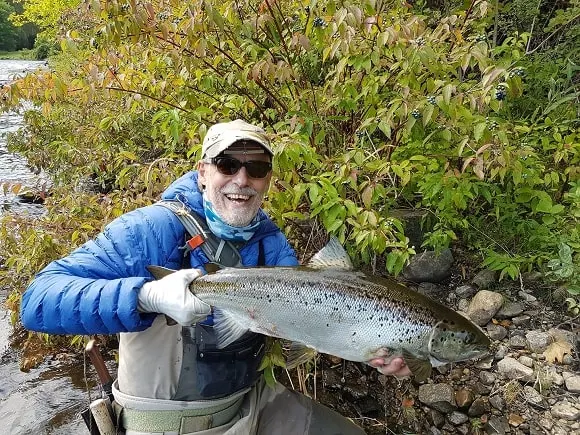
The genuine landlocked salmon refers to two varieties of the Atlantic salmon type: Salmo salar Sebago (landlocked lake salmon) and Salmo salar Ouananiche (landlocked river salmon).
These types of Atlantic salmon, which are genetically identical to the common Atlantic salmon, but sometimes still referred to as subspecies, are fish that do not have access to the ocean and are considered entirely landlocked.
Landlocked salmon will spawn directly in their native river systems or the tributaries connected to their respective lake habitats. Their freshwater-based life cycles remind more of that of trout than that of conventional salmon.
DID YOU KNOW: Landlocked salmon do not reach the same size as their saltwater equivalents and most commonly reach a maximum weight of 20-25lb.
One of the most prominent examples of landlocked lake salmon is the population found in Sebago Lake (Maine), which is where this salmon type got its name from. It was here, in Maine, that the first landlocked salmon populations were discovered back in the 1860s.
Another one includes the famous indigenous landlocked Atlantic salmon population of Lake Ontario. Once upon a time, it was considered the world’s largest population of freshwater-dwelling Atlantics.
Until the late 19th century, that is, when the fish practically vanished due to environmental changes and overfishing.
Today, only a few wild Atlantics remain in Lake Ontario. However, large-scale restoration efforts are implemented to restore a strong and healthy Atlantic salmon population to Lake Ontario and its tributaries.
The annual stocking efforts yield good success, and there is even some natural production going on, but only time will tell if the lake’s population can achieve truly sustainable levels once again in the future.
A well-known example of Ouananiche salmon includes the population that is found in George River, a mighty river system that flows along the Quebec-Labrador border.
It must be mentioned that the Pacific salmon types can also be landlocked, even though they mainly achieve this status by being stocked in a lake or river system.
However, there are regions in the Pacific Northwest where naturally occurring Pacific salmon populations can also be found!
You can read about the distribution of all the different landlocked salmon types further down in this article!
Are Landlocked Salmon Natural?
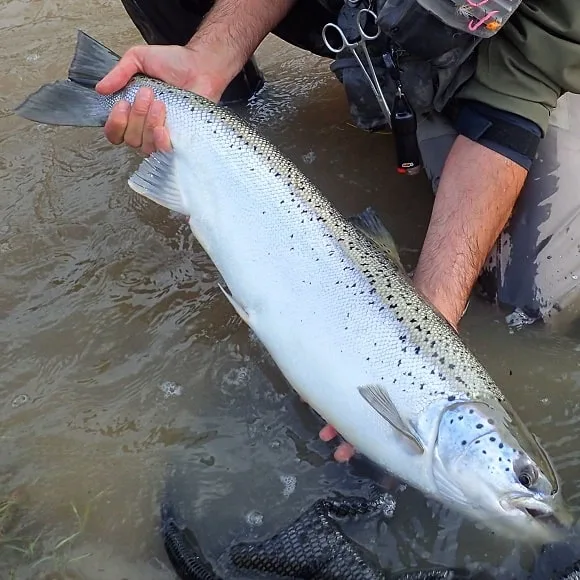
Historically, large wild populations of landlocked Atlantic salmon have occurred in both North America and Northern Europe.
Research suggests that these fish found their way into large, deep freshwater lakes near the end of the last ice age when the glaciers started to retreat some 10.000 to 12.000 years ago.
As the gigantic ice sheets receded, they connected the newly formed inland lakes to the Atlantic ocean via rivers and streams. This, in turn, made it possible for the salmon to enter said inland lakes.
Over time, water levels decreased, and the connections between fresh and saltwater disappeared, trapping the salmon in the lakes and rivers and turning them into landlocked fish.
During the 19th century, the natural populations started to shrink, primarily due to environmental circumstances and human impact. And so, people in both the US and Canada began to stock landlocked salmon instead.
These stocked populations of Atlantics, and, since the 1960s, of Pacifics as well, can, of course, not be considered natural, even though they have inhabited the waters for many decades and natural reproduction often occurs.
Less research has been done on the origins of the wild landlocked Pacific populations, but it is suggested that they have become landlocked simply because of the construction of artificial barriers that block their route back to the sea.
RELATED ARTICLE: Are Salmon Freshwater or Saltwater Fish? (Or Can They Be Both? Find out by reading this article!)
Where Can Landlocked Salmon Be Found?
Both landlocked Atlantic and Pacific salmon can be found in many regions all over the North American continent.
Additionally, landlocked Atlantics also inhabit a few European lakes and river systems.
Where Are Landlocked Atlantic Salmon Found?
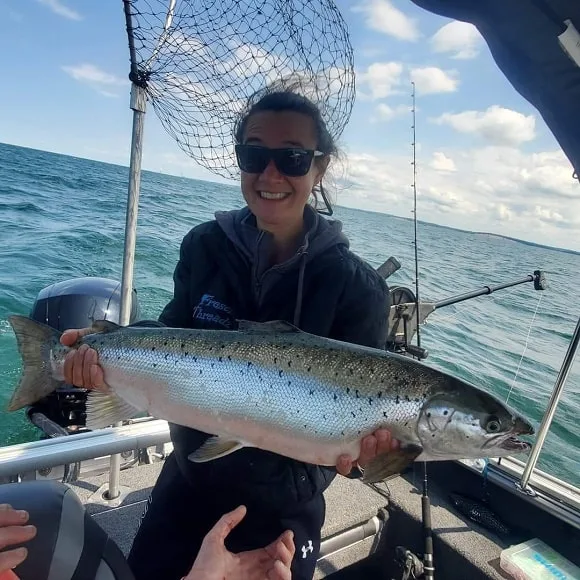
caught aboard Reel Naturalz Charters & Guide Service (courtesy of Jason Dzikiewicz)
In the US and Canada, landlocked Atlantics, both natural and stocked, can be found all along the northern Atlantic coast.
The wild populations of North America were first discovered in the following lakes:
- Lake Sebago, Green, Grand, and Sebec (Maine)
- Lake Ontario (New York, Ontario)
- Lake Champlain (New York, Vermont)
Since the decline of the natural populations, they have been stocked in the Great Lakes region, primarily in Lake Ontario, Lake Huron, and St. Mary’s River.
In Canada, there are many populations of landlocked Atlantic salmon in the provinces of Quebec, Labrador, Newfoundland, Nova Scotia, and New Brunswick.
In Europe, a couple of lakes and rivers hold landlocked Atlantics as well, even though they can be considered extremely rare.
The perhaps biggest population can be found in the Swedish lake Vänern, which also happens to be the European Union’s largest freshwater lake system.
Where Are Landlocked Pacific Salmon Found?
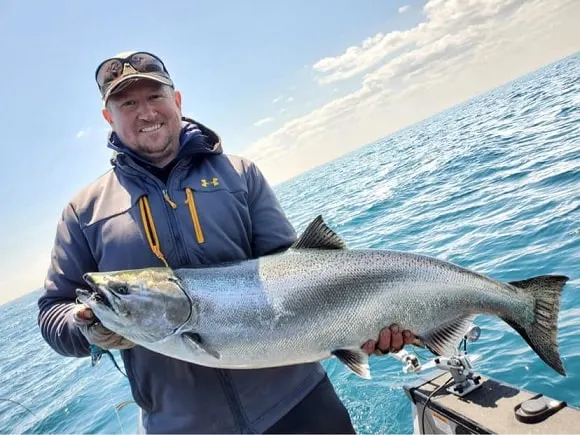
Landlocked Pacific salmon have been stocked in many water bodies in the US. The biggest and perhaps most popular stocked populations inhabit the Great Lakes and their tributaries.
Every year, thousands of them are caught by enthusiastic anglers from both boat and shore.
Of course, the Pacific Northwest is home to many stocked and wild landlocked Pacific salmon as well.
Most notably, the region is known for its many kokanees, the landlocked version of the sockeye salmon. The kokanee salmon is a highly prized game and food fish in North America.
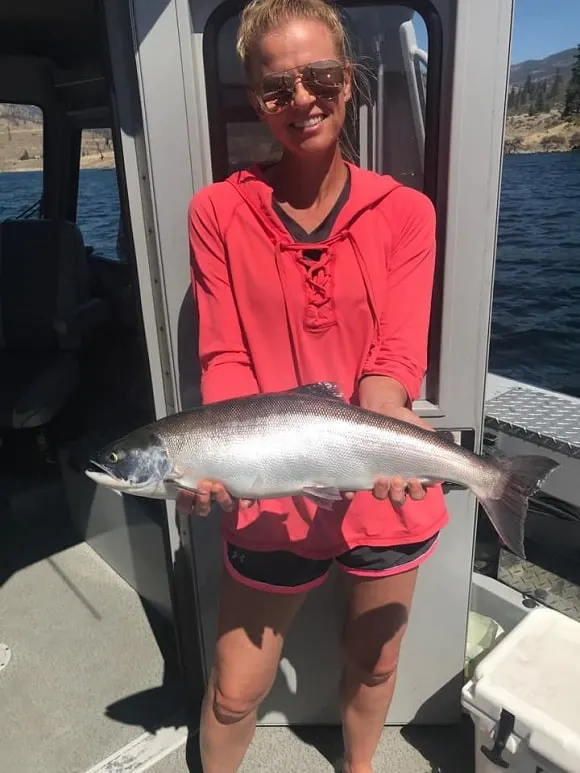
It is extremely popular among salmon anglers as it is a lot of fun on the rod and tastes exquisite, much like its saltwater relatives.
Interestingly, researchers have also discovered smaller, scattered wild landlocked chinook (king) salmon populations in this region.
Wild chinooks have been reported in a few river systems in California, Idaho, Washington, and, more recently, also in Oregon.
PRO TIP: Some of the main facts of this article can also be found in the related landlocked salmon web story!
Can All Salmon Types Be Landlocked?
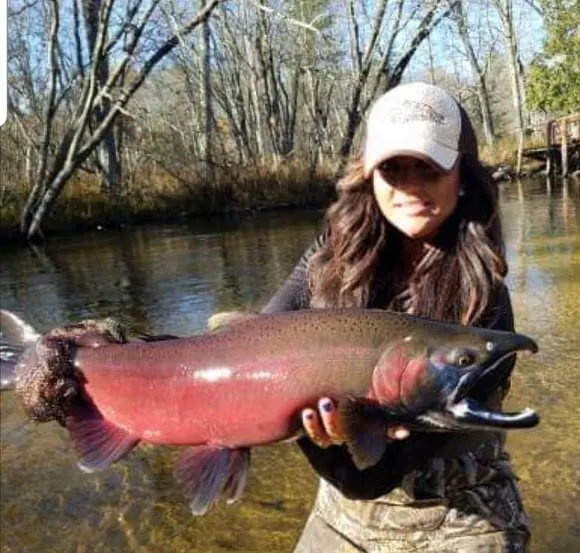
Both the Atlantic salmon and all five Pacific types of salmon can be landlocked in rivers and lakes.
The most common types of landlocked salmon include:
- Atlantic
- Chinook/King
- Kokanee (Sockeye)
- Coho
On the other hand, there are only a few landlocked populations of chum and pink salmon, although there is a stable population of pinks inhabiting the Great Lakes.
Can Landlocked Salmon Reproduce?
Just as anadromous salmon, meaning fish that are born in freshwater and spend most of their lives in saltwater, reproduce in rivers, so do landlocked salmon. Their solely freshwater-based life cycle does not, in any way, interfere with their reproductive abilities.
As was described at the beginning of this article, there are both landlocked lake-dwelling and landlocked river-dwelling salmon.
Both varieties can only spawn in flowing freshwater, which means that the lake-dwelling landlocked fish also need access to rivers and streams (usually in the form of tributaries).
These fish are referred to as adfluvial, meaning that they are born in a tributary and then migrate to a lake system where they will grow to maturity, just like their parents did.
The solely river-dwelling landlocked salmon variety is instead categorized as fluvial, meaning that they both inhabit and spawn in the same river or tributary system.
RELATED ARTICLE: When Do Salmon Spawn?
How Big Can Landlocked Salmon Get?
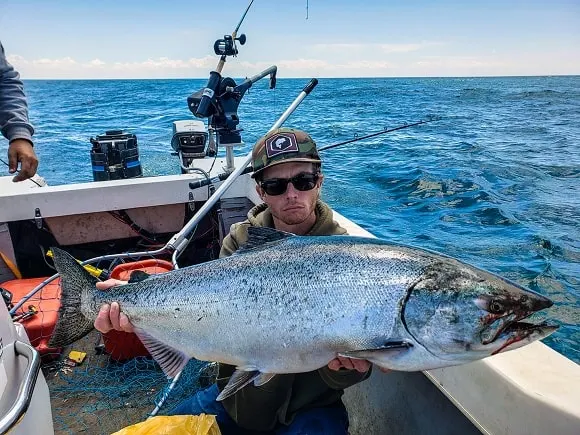
Landlocked salmon have an average length of about 15 to 25 inches and an average weight of 2 to 5 pounds.
In bigger water bodies, such as the Great Lakes, fully mature fish can weigh well over 20 pounds and reach a length of more than 40 inches.
The biggest ever caught Great Lakes landlocked chinook, the biggest of the five Pacific salmon types, is a giant fish that weighed in at an incredible 47lb 9oz and was caught during a guide trip on Lake Michigan in 2021.
It took the 19-year-old record holder more than 40 minutes to reel in his huge catch. What an incredible fish it must have been!
The world record landlocked Atlantic salmon is a fish caught on Torch Lake (Michigan) back in 2010. The fish weighed 26lb 12oz.
Do Sea-Run Salmon Grow Bigger than Landlocked Salmon?
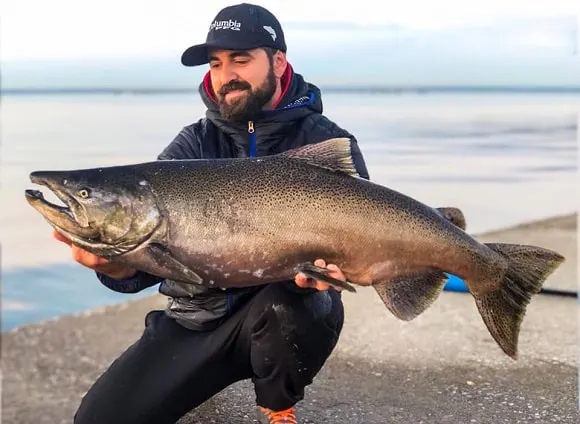
Anadromous salmon vastly outgrow their landlocked versions because they have both more space and food sources in the sea.
And so, while a landlocked chinook of more than 20lb is considered a big trophy fish, the same salmon type caught in the ocean would have to weigh 40, perhaps even 60lb, to earn this title.
Similarly, a sea-run Atlantic salmon would have to weigh at least 40lb to be considered a giant. And that’s a weight that a landlocked Atlantic can’t reach!
RELATED ARTICLE: What Are the Different Types of Salmon? (An In-depth Guide with Pictures of All Salmon Species)
How to Fish for Landlocked Salmon?
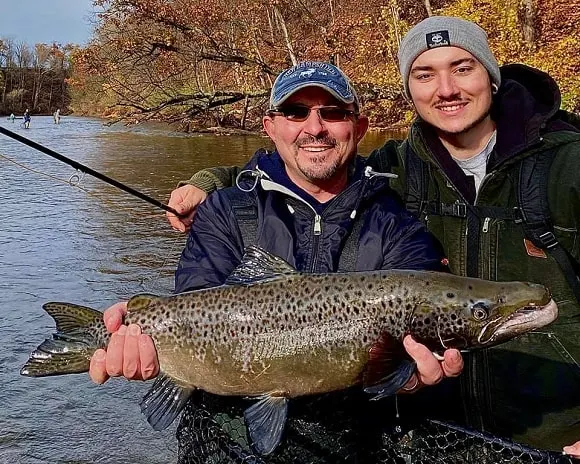
Landlocked salmon can be caught on various lures and baits from both shore and boat. These include flies, streamers, spoons, crankbaits, inline spinners, and salmon plugs.
Many anglers prefer the good old fly rod when fishing tributaries, while others stick to spin fishing for landlocked salmon.
Out on the lakes, many fish are caught trolling down-rigged spoons and salmon plugs over open, deeper water near larger baitfish schools.
Another really effective method when fishing from a boat is to drift, or slow-troll live alewife herring or golden shiners on a slip bobber rig or free line.
Personally, I prefer fishing with live bait, it’s just so much more exciting! Just don’t forget to weigh your bait down enough to get to your intended fishing depth!
Which of the Great Lakes Has the Best Salmon Fishing?
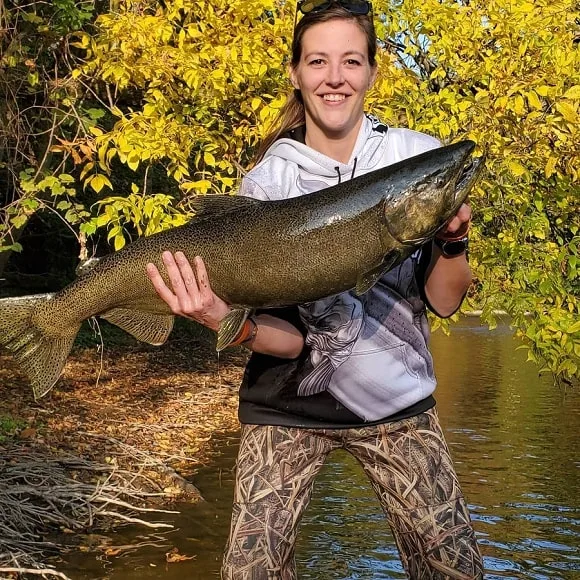
While this question is highly subjective, many anglers, guides, and fishery managers would agree that Lake Michigan and Lake Ontario offer the best salmon fishing in the Great Lakes region.
Lake Michigan offers excellent fishing opportunities for coho and chinook salmon, and the populations here are both large and vibrant, producing many trophy fish every year.
On the other hand, Lake Ontario and its tributaries are a top-rated fishing destination for Atlantic salmon anglers. Here, it is possible to catch Atlantics year-round, and even if catching them is far from easy, there’s always the chance of hooking up to a really big fish!
I also went ahead and asked 100 anglers who fish the Great Lakes for their personal preferences regarding the best salmon lakes. Their answers seem to confirm the statements mentioned above:
| Best Great Lake for Salmon Fishing | Votes |
| Lake Michigan | 60% |
| Lake Ontario | 40% |
Why Were Salmon Stocked in the Great Lakes?
In the 60s, aggressive commercial fishing and the invasive sea lamprey had wiped out most of the lake trout and burbot populations in Lake Michigan, Huron, and Superior.
As a result, the lakes’ alewife populations exploded and reached unsustainable levels, resulting in millions of fish dying and washing up on the Great Lakes’ beaches.
Conservationists estimated that roughly 95% of Lake Michigan’s biomass was made up of alewives. They simply didn’t have any natural predators in their habitat anymore!
And while many expressed concerns about this development, Howard Tanner, then chief of the Michigan Department of Conservation’s Fish Division, saw an opportunity and took action.
Tanner’s plan was simple; introduce salmon in the lakes to stabilize the alewife populations and develop a recreational fishing industry in the Great Lakes area.
After a few failed attempts, Tanner’s idea bore fruits, and the Great Lakes started to have healthy and growing populations of first cohos, kokanees, and even chinooks.
Thanks to the abundance of food, the salmon thrived and could reach a respectable size, leading to a booming recreational fishing industry that is still strong today.
Additionally, the presence of salmon in the lake systems has improved the water quality immensely. Back in 1960, Lake Michigan’s visibility was about 10 inches. Today, you can see down 100 feet or more during springtime, when the water is cold and clear.
Are Landlocked Salmon Good to Eat?
Landlocked Atlantic and Pacific salmon can and often do taste deliciously in many lakes and rivers.
Of course, the taste and quality of the meat will be determined by factors such as water quality, turbidity, type of food source, and the season in which the fish was caught.
Because while eating pre or post-spawn Atlantic salmon is generally not considered problematic, eating post-spawn landlocked Pacific salmon is not always recommended.
That is because Pacific salmon, unlike their Atlantic counterparts, start to deteriorate on their journey to their natal spawning grounds and die after the act is done.
In fact, they can start to rot alive before they spawn and eventually pass away. Eating these so-called zombie salmon isn’t precisely a culinary experience and should mostly be avoided.
Also because they can carry bacteria, fungi, and diseases during this final stage of their lives. You can read up on the interesting topic of zombie salmon by reading this related article.
Related Articles
- Atlantic Salmon vs. Pacific Salmon (How Are They Different?)
- Why Do Salmon Die After They Have Spawned (Salmon Facts Explained)
- Steelhead vs. Salmon (What’s the Difference?)
- How Big Do Salmon Get? (Average and Maximum Sizes for All Salmon Types)
Featured image courtesy of Mia and Jason Carstens (True North Guide Service)

